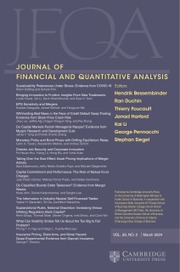Article contents
Abstract–Behavioral Risk Constraints in Capital Budgeting
Published online by Cambridge University Press: 19 October 2009
Extract
This paper presents a descriptive theory of risk that may be applied to capital budgeting decisions. The proposed theory is actually much more general than a theory of financial risk and is consistent with reported laboratory experiments. The essential feature of this theory is the role that risk descriptively plays as a constraint in the decision-making process. Specifically, risk is modeled as a chance constraint such that projects are rejected if the probability of “failure” is larger than some prescribed level. This has the effect of making all investment decisions chance-constrained programming problems, although some classes of problems have trivial solution procedures. In this context, risk serves to “strike out” or eliminate alternatives from consideration.
- Type
- Corporation Finance
- Information
- Copyright
- Copyright © School of Business Administration, University of Washington 1974
- 2
- Cited by


